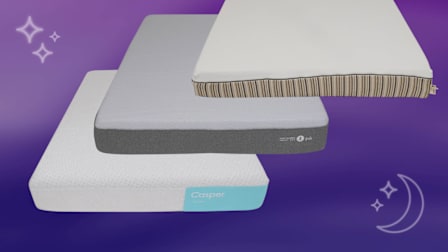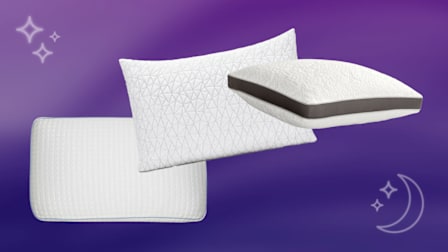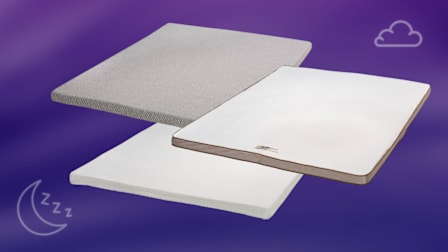Best Sleep Setups for Sleep Apnea, Acid Reflux, Asthma, and Allergies
Expert advice to help make bedtime more comfortable instead of a challenge
When you shop through retailer links on our site, we may earn affiliate commissions. 100% of the fees we collect are used to support our nonprofit mission. Learn more.

Punching the pillows, flipping them over, sitting up, increasing the humidity in your bedroom, then lowering it—these are a few of the things we do to try to fall asleep. Bedtime should be relaxing. But if allergies, asthma, sleep apnea, or gastroesophageal reflux (GERD) are keeping you awake, it can feel like a nightly stress test.
We’ve got good news. With the right combination of a good sleep position and bed setup, you might be able to vastly improve the situation and get the kind of quality rest your body, mind, and spirit deserve. Here’s expert advice for finding sleep comfort if you have these common ailments.
Best Sleep Setup for Sleep Apnea
According to the American Academy of Sleep Medicine, almost 30 million adults in the U.S. have sleep apnea, a condition that causes them to stop breathing repeatedly during sleep. If you suspect you have it, talk with your doctor.
If you’ve already been diagnosed with sleep apnea, you’re best off sleeping on your side, says Michelle Drerup, director of behavioral sleep medicine at Cleveland Clinic Sleep Disorders Center. Side sleeping helps decrease the pressure on your airway. “This, in turn, keeps the tongue and soft palate from collapsing back into the throat,” she says, and helps minimize the frequency of breathing disruptions during the night.
Best Sleep Setup for GERD
First things first: According to Meyer Solny, MD, a gastroenterologist at Weill Cornell Medical College in New York City, people who have been diagnosed with GERD, or gastroesophageal reflux disease, will have a better chance of a good night’s sleep if they refrain from eating 3 hours before bedtime. And Solny says that sleeping on the left side is best.
Elevating your head and torso in bed can make a big difference. Aim for a 20-degree angle, with your head 7 or 8 inches higher than your feet to ensure that gravity works with you, not against you. “This helps keep stomach acid in the stomach, emptying it down into the small intestine rather than allowing it to flow upward into the esophagus,” Solny says.
To achieve the optimal angle, you can use an adjustable bed frame, a wedge pillow, or an anti-reflux pillow designed for elevated lying on your side. If you’re looking for a new mattress, the innerspring Bob-O-Pedic Treasure Cushion Dual gets high marks for side sleeping and works with an adjustable frame. You can find many more options in our mattress ratings.
Best Sleep Setup for Asthma or Allergies
Shradha Agarwal, MD, an allergist and immunologist at Mount Sinai Hospital in New York City, says it’s common for people to develop asthma or allergies later in life, due to many factors: genetic, hormonal, environmental, and more. Whether you’re newly anointed or have been living with asthma or allergies forever, you can make some tweaks to keep from tossing and turning.
Agarwal advises sleeping on your back with your head elevated. “This helps alleviate congestion and reduce mucus buildup by allowing mucus to drain with gravity,” she says. You can use regular bed pillows, bed risers under the feet at the head of the bed, or a wedge pillow to raise your head. You can also consider an adjustable bed frame.
Why elevate? If you’re lying flat, mucus can collect in the back of the throat, causing coughing and difficulty breathing, Agarwal says. For dedicated side sleepers who can’t imagine switching to their back, Agarwal advises elevating the head and sleeping on the left side, which minimizes reflux, another cough trigger. In any case, make an effort to stay off your stomach. “Sleeping on your stomach is the worst since it reduces free airflow to the lungs,” she says.
Of course, materials matter when managing allergies or asthma. “Latex and memory foam mattresses are good options since they resist allergens,” Agarwal says, but some people are sensitive to latex. A medium-firm mattress will provide the best support.
The Earthfoam Organic Medium latex mattress gets high marks for back sleepers of all sizes. If latex sensitivity might be an issue for you, opt for a memory foam mattress, like the Casper The One or Tempur-Pedic Cloud Medium. Here’s a closer look at how these three mattresses perform in our lab tests:
In terms of bedding, “cotton is a smart choice, as certain synthetics may trigger allergies,” Agarwal says. Then again, synthetics such as microfiber and down alternatives can be resistant to dust mites. If you think you’re allergic to a material in your bedding, see an allergist to pinpoint the problem before shopping.
Here are two high-scoring sheet sets from our tests that might provide relief:
And here are a few tweaks for the bedroom, suggested by Agarwal, that could help you sleep more comfortably if you have asthma or allergies:
• Avoid carpeting and heavy drapes, which can collect dust mites.
• Dust furniture, vacuum floors, and change bedding regularly.
• Use removable dust mite covers on mattresses and pillows, and wash the covers often.
• Keep pets out to minimize dander.
• Shower before bed to remove any pollen from your skin and hair.
• And get an air purifier with a HEPA filter. For options, see our comprehensive air purifier ratings and our air purifier buying guide.
Editor’s Note: A version of this article also appeared in the March 2025 issue of Consumer Reports magazine.



















